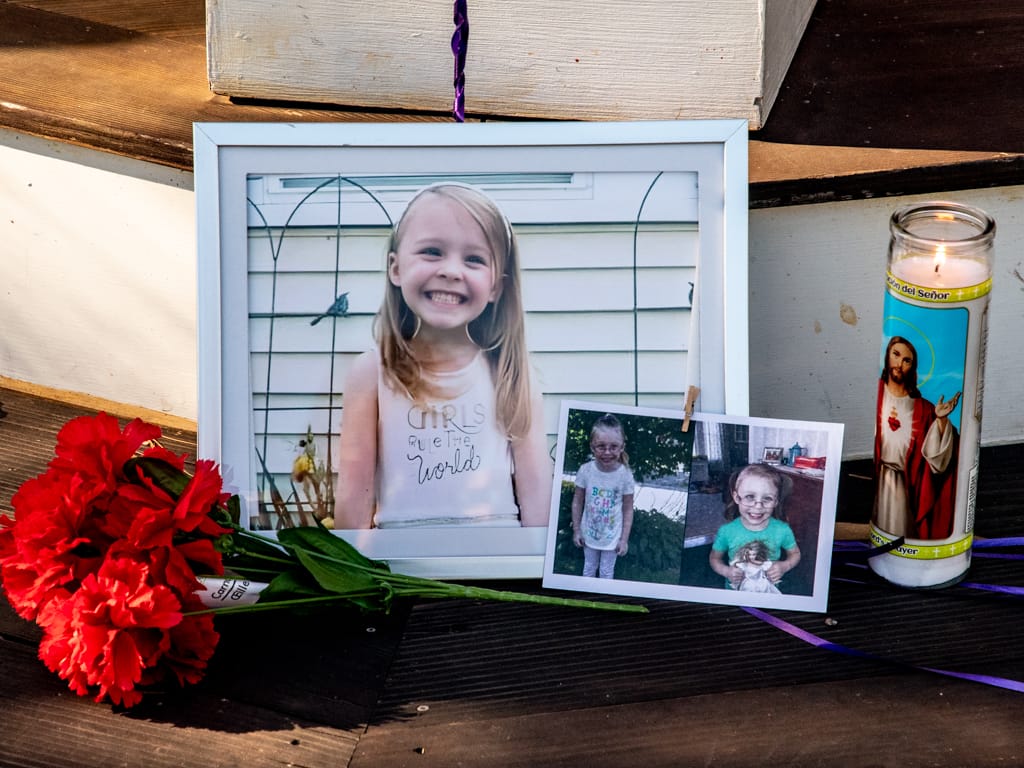State wants Adam Montgomery to serve 56 years-to-life for killing Harmony, his disabled daughter
Prosecutors in the case of Adam Montgomery, convicted in the beating death of his 5-year-old daughter and of abusing her corpse, are recommending he be sentenced to 56 years to life because, they maintain, there is no hope of rehabilitating him.
MANCHESTER, NH – Prosecutors in the case of Adam Montgomery, convicted in the beating death of his 5-year-old daughter and of abusing her corpse, are recommending he be sentenced to 56 years to life because, they maintain, there is no hope of rehabilitating him.
In the state’s sentencing memorandum, filed Monday in Hillsborough County Superior Court North, Senior Assistant Attorney General Benjamin J. Agati and Assistant NH Attorney General R. Christopher Knowles, said the case involves the murder of an innocent 5-year-old girl at the hands of her biological father, Montgomery, 34, a man with an extensive criminal history. They said earlier sentences tried to deter further criminal behavior by Montgomery using more than simply incarceration but that failed, “leaving the Court little hope of rehabilitation. Accordingly, for the charges upon which he has been convicted, the Court is left with few sentencing goals it can accomplish beyond deterrence and punishment.”
For those reasons, they said they are recommending Montgomery be sentenced to 4 to 8 years in the New Hampshire State Prison on the second-degree assault charge for blackening Harmony Montgomery’s eye in July of 2019; 3 ½ to 7 years for falsifying physical evidence; 3 ½ to 7 years for witness tampering; 12 months for abuse of a corpse; and 45 years to life for second-degree murder. Each sentence is consecutive to the other for a total of 56 years to life. He could petition the court for release after serving 43 years.
And those 56 years are to be consecutive to the 32½ to 65-year sentence he is already serving for convictions of being an armed career criminal, stolen weapons charges and other offenses.
Montgomery is scheduled to be sentenced Thursday at 1 p.m. in Superior Court.
As of early Tuesday afternoon, the defense had not filed its recommendation on sentencing.

In summarizing the case, prosecutors said the charges stem initially from Montgomery assaulting his daughter in July of 2019. He told his uncle he injured her while “bashing her around the fucking house.” Then came the Dec. 7, 2019 murder of Harmony, which then culminated in him transporting and consolidating her body over three months, ending with his March 4, 2020 disposal of her corpse.
The charges of falsifying physical evidence, tampering with a witness, and abuse of a corpse occurred between Dec. 7, 2019, and March 4, 2020. The murder of Harmony was not uncovered for several years. Law enforcement did not know she was missing until late in 2021, two years after she had been murdered.
Ultimately, when Montgomery was confronted by a court order to produce Harmony to DCYF (Department of Children, Youth and Families), he refused. Despite Montgomery’s concession at trial that he disposed of Harmony’s body, her remains have not been found, and as a result, she has been deprived of a proper burial, prosecutors said.
Harmony died after a brutal number of attacks by her father that began in the early morning hours of Dec. 7, 2019 when he struck Harmony repeatedly on her head and face because she had a bathroom accident in the car. The family of five were living in their Chrysler Sebring after being evicted from their home.
Montgomery did not attempt to treat her injuries or change her soiled clothes after that assault, prosecutors said. He placed a blanket over her and went back to sleep.
Several hours after the first attack, Harmony had another bathroom accident and Montgomery attacked her again. This time, the attack was far more severe in violence and duration. Montgomery struck Harmony numerous times while driving, stopping at lights several times to continue the attack. He only stopped striking Harmony when he felt something “different” and acknowledged out loud that he believed he “really hurt her this time.” Like the first attack, Montgomery did nothing for Harmony after this second attack. Shortly after the second attack, the defendant realized that Harmony was dead and “folded her” into a duffle bag.
In the months following Harmony’s murder, Montgomery compressed her body into a series of bags, treated it with extreme temperatures and chemicals, and ultimately disposed of her corpse, while forcing his wife, Kayla Montgomery, a witness to his crimes, to lie to protect him.
“Harmony died in pain and fear on Dec.7, 2019,” the prosecutors wrote in their memorandum. “But unfortunately, that was not the first time the defendant had caused Harmony emotional and physical pain. In July 2019, the defendant struck Harmony with such force that he altered the profile of her face, witnesses testified regarding the extent of Harmony’s injury and the defendant’s efforts to conceal her and obstruct the DCYF caseworker’s efforts to investigate her injury. The Court also heard that in the week leading up to Harmony’s murder, the defendant repeatedly punched Harmony when she had bathroom accidents and covered her with a blanket to conceal her injuries,” the attorneys general wrote.
Montgomery has never shown true remorse for Harmony’s death, according to the prosecutors.
Montgomery, they said, may counter that he expressed remorse by admitting he falsified physical evidence and abused Harmony’s corpse. They argue, however, that Montgomery committed to a strategy of admitting to crimes where the proof was incontrovertible, such as evidence of his finger and palmprints in the ceiling surrounding Harmony’s blood.

“As such, he should get no benefit from having admitted to falsifying evidence and abusing a 5-year-old’s corpse,” prosecutors said.
They also pointed out that witnesses testified to Montgomery’s animosity towards Harmony. One witness said Montgomery admitted he hated Harmony to his core.
“The defendant’s dislike of Harmony and her frequent bathroom accidents is what fueled his anger on the day of the murder, and gave him the impetus to vent his frustrations on Harmony. The fact that the defendant had this animosity towards Harmony and was hitting her in the week prior to her murder is an aggravating factor. The murder was not a quick, impulsive act. Each time the defendant struck Harmony, he had an opportunity to stop. Yet after short breaks in the assault as he drove away from the methadone clinic, the defendant continued to strike Harmony. Each time he struck Harmony, the defendant, made a concerted effort to hurt her, only stopping when he “felt something” different,” they wrote.
They also said that in the years following Harmony’s death, Montgomery profited from Harmony by claiming state and federal benefits. At Montgomery’s direction, Kayla Montgomery filed forms for the couple to receive benefits while telling family members that investigators are “wasting their time” searching for Harmony.
“This conduct, the audacity to profit from Harmony after her death is more proof of the defendant’s lack of remorse,” the prosecutors said.
As part of the sentencing memorandum, prosecutors detailed Montgomery’s past criminal history dating back to 2007 which included convictions for first-degree assault, armed robbery, assault and battery with a dangerous weapon (2010 conviction), assault and battery with a dangerous weapon (2014 conviction), larceny from a person, criminal threatening, and being an armed career criminal of two separate firearms.
On April 4, 2008, Montgomery was convicted in Hillsborough County Superior Court North of criminal threatening after he pointed a knife at a 15-year-old girl and called her a bitch. He was given a 12-month suspended sentence.
In Massachusetts on Feb. 14, 2008, he was charged with one count of home invasion, four counts of assault and battery with a dangerous weapon, one count of possession of cocaine with intent to distribute, and other minor drug possession offenses. The charges stem from a Feb. 14, 2008 incident in Malden, Mass. in which officers responded to domestic-related disturbance at an apartment complex. As officers approached the apartment door, Montgomery and his accomplice emerged from the unit.
Montgomery had a black handgun in his right hand and pointed it at the chest of one of the officers. The officer was able to slap the firearm out of Montgomery’s hand and wrestle him to the ground. Montgomery was arrested. One witness, Lyndsay Clark, reported Montgomery and his accomplice entered her apartment while pretending to be a family member.
Once the door was opened, the two men pushed past several of the occupants of the home and Montgomery put his gun to Kellie Barnsfield and began yelling “where’s the fucking money, where’s the fucking money.” Montgomery kept pointing the gun at them as he went through the apartment.
Barnsfield told police Montgomery pointed a gun at her and demanded money. She fell to the floor crying and urinated in her pants. Montgomery then forced her to her feet and into another room where she stood in front of her three-year-old daughter’s bedroom, prohibiting him from entering.
Montgomery and his accomplice stole their jewelry that was lying in plain sight. She said Montgomery then put the gun to her neck and ordered her to show him where the safe was located. Barnsfield omplied and then was able to flee the apartment while Montgomery was taking items out of the safe. When police searched Montgomery following his arrest, they found ten individually wrapped plastic wraps containing a white powdery substance believed to be cocaine.
He pleaded guilty to armed robbery and assault and battery with a dangerous weapon. The sentence was concurrent to a 2-to-4-year sentence he was given in connection with a May 6, 2008 incident in which he stabbed an individual in the leg.
In October 2014, Montgomery was involved in a shooting in Haverhill, Mass. According to the prosecutors, Montgomery shot Robert Jacobs in the head. Jacobs survived and when interviewed by police said that Montgomery, who was known as “Ace,” shot him when he tried to rob Jacobs after meeting him to buy three grams of heroin. Jacobs said Montgomery pulled the gun on him and tried to take the drugs from him. A struggle ensued, and the gun went off. Montgomery also suffered a gunshot wound in the incident after others pulled him off Jacobs and a man wrestled the gun from Montgomery and then shot him.
Montgomery was convicted of assault and battery with a dangerous weapon and larceny in connection with the incident.
In October 2019 in Manchester, Montgomery stole two firearms — a shotgun and an AR-15 rifle –from the home of Christopher and Kimberly Frain. Montgomery later sold the guns for cash and drugs.
He was convicted of two counts each of armed career criminal, theft by unauthorized taking and receiving stolen property. In total, he was sentenced to 32 ½ to 65 years in prison.
Presently, he has two other charges pending against him including another count of armed career criminal and being a felon in possession.

The prosecutors said the death of Harmony, a 5-year-old child, who was disabled and blind in one eye, has had an immeasurable effect on her next of kin, the community of Manchester and the state as a whole.
“The defendant robbed Harmony and her family of the person she was going to become. He killed all potential she held and eradicated the potential good she could do for her family and the community. Harmony left behind young siblings, one who was one year old when he last saw her, and another born later who will never know her,” they wrote.
Montgomery, they said, beat a helpless child to death in a series of brutal attacks.
“When Adam Montgomery murdered Harmony, he was already a repeat violent felony offender who was trading in firearms and drugs around his children. His history shows that prior to murdering Harmony, he was escalating in violence. Shortly after his release from prison for shooting his associate in the face, he was awarded custody of Harmony. He did not have custody of her for six months before the first documented assault in July 2019, and he had her for less than a year before he beat her to death. These actions of their own accord show a lack of prospects for rehabilitation. Punishment and the protection of the community must therefore be a significant sentencing goal for the court. The defendant has shown the court over, and over, and over again that he presents a danger to the community, to the people he is closest to, to whom he calls friends, to women, to children, and to police officers,” the prosecutors said.

